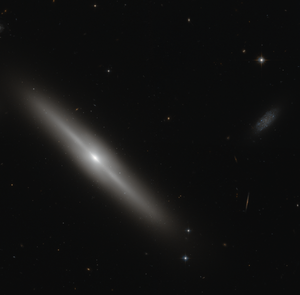NGC 5308
| Galaxy NGC 5308 |
|
|---|---|

|
|
| NGC 5308 and SDSS J134646.18 + 605911.9 ( Hubble Space Telescope ) | |
| AladinLite | |
| Constellation | Big Bear |
|
Position equinox : J2000.0 , epoch : J2000.0 |
|
| Right ascension | 13 h 47 m 00.4 s |
| declination | + 60 ° 58 ′ 23 ″ |
| Appearance | |
| Morphological type | S0- |
| Brightness (visual) | 11.4 mag |
| Brightness (B-band) | 12.4 mag |
| Angular expansion | 3.7 ′ × 0.7 ′ |
| Position angle | 60 ° |
| Surface brightness | 12.3 mag / arcmin² |
| Physical data | |
| Affiliation | LGG 360 |
| Redshift | 0.006665 ± 0.000017 |
| Radial velocity | 1998 ± 5 km / s |
|
Stroke distance v rad / H 0 |
(95 ± 7) x 10 6 ly (29.1 ± 2.0) Mpc |
| history | |
| discovery | Wilhelm Herschel |
| Discovery date | March 19, 1790 |
| Catalog names | |
| NGC 5308 • UGC 8722 • PGC 48860 • CGCG 295-012 • MCG + 10-20-29 • 2MASX J13470039 + 6058229 • GC 3662 • H I 255 • h 1647 • LDCE 1005 NED002 | |
NGC 5308 is a lenticular galaxy of Hubble type S0 in the constellation Ursa Major at the northern sky , the estimated 95 million light-years from the Milky Way 's center.
The object was discovered on March 19, 1790 by Wilhelm Herschel with the help of his 18.7-inch reflector telescope and was later included in his New General Catalog by Johan Dreyer .
Web links
- astronews.com: Picture of the day May 17, 2016
